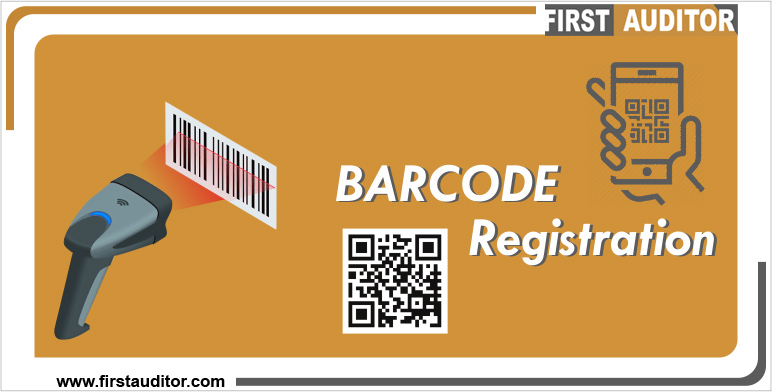BARCODE Registration is given by the first auditor in Chennai, Tamil Nadu.We are the top BARCODE Registration service provider. In Coimbatore, Madurai, Tirupur, Trichy, Thanjavur, Erode, Salem, Namakkal, Karur, hosur, tuticorin, krishnagiri, Cuddalore, Kanyakumari, and Pondicherry, we offer BARCODE Registration Consultant Service. We provide low-cost BARCODE Registration Service. We provide the service at a lower cost and more efficiently than our rivals.
What is Barcode?
A machine-readable image with vertical black bars and varying-width spaces is known as a "barcode picture." In order to expose a precise 12 or 13-digit long sequence of numbers, the black bars and spaces must be created and decoded in a specific way.
Why do I need a Barcode
Today, the majority of retail establishments use a barcode system to streamline inventory management and reduce labour costs. Therefore, it is advised that one apply for a barcode if they plan to sell their goods in brick-and-mortar or online retailers like Amazon, Flipkart, Paytm, etc.

Importance of Barcode
- In the store, it is simple to identify any product or commodity.
- The mother carton box might be given a Unique Identifying Number (UID) before packing the item.
- For pertinent data such order number, items packed, quantity packed, destination, etc., database linkage of UID number is simple.
- Better communication between the material's sender and receiver is made possible by bar codes. Prior to a shipment arriving, it communicates the information to the retailer.
TYPES
Various Type of Barcodes:
Different barcodes with the ability to store several pieces of data are required for various applications.
- GS1 India Barcode Registration
- GS1 Family of EAN/UPC Barcodes
- Data bar codes from the GS1 family
- GS1 1D Barcodes
- GS1 2D Barcodes
- Turnover for the business
- Needed number of barcodes
- Period of subscription
APEDA, CII, FIEO, IMC, FICCI, ASSOCHAM, Spices Board, IIP, and BIS are founding members of GS1 India, an organisation that was registered under the Societies Registration Act of 1860. A non-profit global standards body for barcode registration is called GS1.
The following categories are used to group GS1 barcodes:
This is an instantly identifiable barcode, which can be found on practically all consumer goods in the world. Of all the GS1 barcodes, they have the most history and usage.
Fresh food products typically have barcodes from Data Bar on them. In addition to other features utilised at the point of sale, such as the item weight, these barcodes store information like the item's batch number or expiration date.
Highly adaptable 1D barcodes like GS1-128 and ITF-14 make it easier to trace goods over international supply networks. Any GS1 ID key as well as data like serial numbers, expiration dates, etc. can be stored in GS1-128 barcodes. The ITF-14 barcode is suitable for printing on corrugated materials and can only store the Global Trade Item Number (GTIN).
Two-dimensional (2D) barcodes resemble squares or rectangles with a large number of tiny, distinct dots. A single 2D barcode can store a significant amount of data and may still be readable when printed in small print or applied to a product. A wide number of businesses, including manufacturing, warehousing, logistics, and healthcare, use 2D barcodes.
Indian prices for barcodes
The number of barcodes needed, the company's yearly revenue, and the number of years the barcode has been subscribed to all affect the cost of barcode registration in India.
The fees for barcode registration are dependent on the following:
The fees range from Rs. 44,000 to Rs. 2,20,000 depending on all of these variables.
Benefits of Bar Code Registration
- The barcode number applied to the product packaging can now be seen on the Google search engine platform thanks to barcode registration. Following registration, barcode scanning provides readers online with product information from a global database.
- Barcodes allow a business to sell their goods using contemporary retail channel strategies (in-store and online).
- It allows for the universal and clear identification of products.
- A business can easily sell to well-known stores and internet marketplaces.
- A corporation can automatically comply with the Ministry of Consumer Affairs' product data standards once registered.
- Boost online visibility
- Obeying laws and regulations
Documents required for Barcode Registration:
- PAN cards for the applicant company or the owner of a sole proprietorship business
- Copy of the audited balance sheet
- Requesting the allocation of barcodes in a letter on business letterhead
- Evidence of the Applicant Company's Status
- GST/VAT registration documentation or a partnership agreement in the case of proprietorship firms
- Registrars of Companies (ROC) certificate, GST/VAT registration certificate, and memorandum of association in the event of a private or public limited company (MOA)
- Other entities, such as Registered Societies, HUFs, etc. Certificate of GST/VAT registration or Registrar of Society (ROS) certification
- copy of a company's cancelled check
